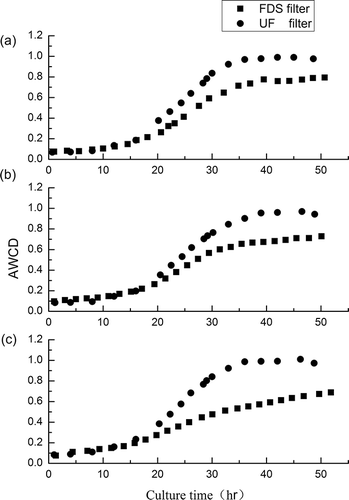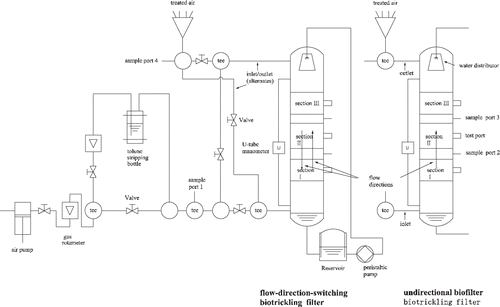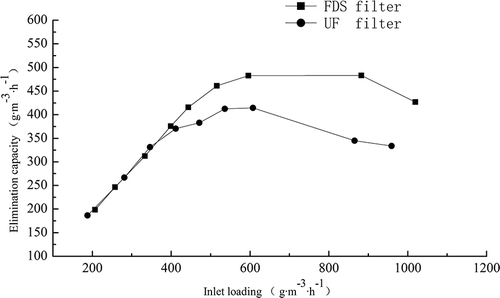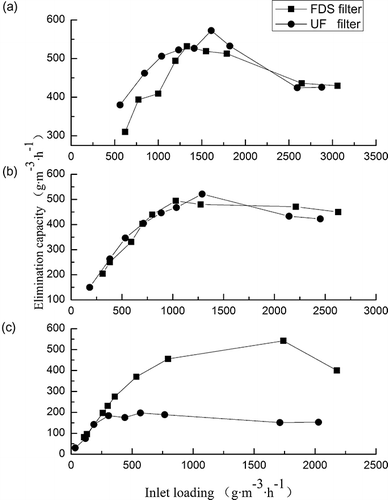Abstract
Because of the characteristics of low operating cost and convenient operation, the biotrickling filter is extensively researched and used to treat low concentration waste gas contaminated by volatile organic compounds (VOCs) and other odors. In this paper, two laboratory-scale biotrickling filters were constructed and toluene was selected as the sole carbon source, and the effects of different waste-gas flow configuration patterns on the purification capacity and the microbial community functional diversity of biotrickling filters were evaluated. The results indicated that the flow-directional-switching (FDS) biotrickling filter had better purification performance, and the maximum elimination capacity reached 480 g·m−3·hr−1, which was 17.1% higher than conventional unidirectional-flow (UF) biotrickling filter. Comparing the purification capacities of different sections in two biotrickling filters, the maximum toluene elimination capacity of section III in FDS system could reach 542 g·m−3·hr−1, which was 2.8 times as great as that in UF system, which resulted from the difference of elimination capacity in two systems. By analyzing the metabolic activity of two systems by community-level physiological profiling (CLPP) with Biolog (Biolog Inc., Hayward, CA) ECO-plate technique, metabolic activity in three sections of FDS system was higher than that of UF system. The metabolic activity was the highest in section III of FDS system and 46.8% higher than that of UF system. Shannon index and McIntosh index of section III in FDS system were 6.2% and 31.5% higher, respectively, than those of UF system.
The flow-directional-switching (FDS) biotrickling filter had a better purification performance than unidirectional-flow (UF) biotrickling filter at high inlet loadings, because FDS produced a more uniform distribution of biomass and microbial metabolic capacity along the length of the packed bed without diminishing activity and removal capacity in the inlet section.
Introduction
Biotrickling filter treatment has been considered to be a more attractive technology for control of low concentration waste gas contaminated by volatile organic compounds (VOCs) and other odors due to its characteristics of low operating cost and convenient operation. In the process of using biotrickling filter for removal of VOCs, the purification performance is affected not only by superficial gas velocity, inlet loadings, pH, and temperature, but also by waste-gas flow configuration pattern (CitationSong and Kinney, 2001; CitationAuria et al., 2000; CitationCai et al., 2007). Several research results indicated that the flow-directional-switching (FDS) biotrickling filter could have a higher purification performance than the unidirectional-flow (UF) biotrickling filter, because the former had a more uniform population density in bed layer from top to bottom (CitationIliuta and Larachi, 2004; CitationKennes and Veiga, 2002). Although the effects of different waste-gas flow configuration pattern on the capacity and reliability of biotrickling filter for removal of VOCs have been evaluated (CitationWright, 2005), the fundamental importance of the changes in functional diversity of the microbial community in biotrickling filter under the conditions of FDS and UF are rarely studied.
A variety of methods were developed and used to analyze species identification and changes in the community structure, including traditional culture-based techniques, molecular techniques, and community-level physiological profiling (CLPP) with Biolog (Biolog Inc., Hayward, CA) ECO plates (CitationYang et al., 2010). Compared with the former two methods, CLPP with Biolog ECO-plate technique had advantages of lower cost, being relatively easy to perform, and detecting differences within the bacterial communities in biotrickling filter (CitationGrove et al., 2004, Citation2007).
In this paper, two laboratory-scale biotrickling filters with different waste-gas flow configuration patterns were designed and toluene was chosen as the sole carbon source. Based on the evaluation of the purification performance of two biotrckling filters, the functional diversity of microbial communities of two systems was analyzed by CLPP with Biolog ECO-plate technique.
Materials and Methods
Experimental apparatus
Two identical biofilters were constructed from three sections of organic glass that had an internal diameter of 90 mm and a height of 250 mm. shows the schematic representation of the experimental biotrickling filters. The inert material employed in bioreactors was ceramic rasching rings (8 mm × 10 mm × 10 mm).
Laboratory compressed air was filtered through an air pump, then passed through a rotameter to measure and regulate gas flow rate. An air stripping was used to deliver liquid toluene to a glass-wool wick, where it evaporated into one air stream, which combined with fresh air. The nutrient solution supplied inorganic nutrients and moisture to the filter bed. One combined air stream was conveyed to the inlet of the FDS biotrickling filter (top or bottom depending on the cycle phase) using wriggle pump, and the other was conveyed to the UF biotrickling filter bed. The nutrient solution recipe (CitationGallastegui et al., 2011; CitationWu et al., 1998) contained (in g·L−1) (NH4)2SO4 1.0, K2HPO4 3.2, KH2PO4 0.4, MgSO4·7H2O 0.2, NaCl 0.1, CoCl2 0.001, CaCl2 0.01, FeSO4 0.003, ZnSO4 0.003, MnSO4 0.003, pH 7.0. The temperature was maintained at 25 °C.
Experimental methods
The seeded bacteria were Pseudomonas putida, Gordonia sp., and Ochrobactrum sp., which were originally isolated from the activated sludge of a coking plant. Toluene was chosen as the sole carbon source and inducer (CitationCheng, 1994; CitationGeorge and Garrity, 1984). FDS and UF biotrickling filters were fast started by the creative “gas–liquid-phase joint inoculation method” (CitationZhou et al., 2005). The biofilm was ripe after 12 days and the purification performance of systems was studied under the conditions that the superficial gas velocity was 86 m·hr−1 and inlet concentrations of toluene were ranged from 800 to 1000 mg·m−3.
Sampling and analysis methods
Flow-stream grab samples were collected from column ports at the outlet and bed depths of 500, 950, and 1400 mm using sampler at regular times. Toluene concentrations were determined by a gas chromatography. The temperatures of the column, injector, and detector were 90, 150, and 150 °C, respectively. Nitrogen flow rate was 60 mL·min−1.
The functional diversity of the microbial communities was measured by Biolog ECO plates (CitationGrove, 2004; CitationWeber et al., 2007). One gram of packed bed samples (wet weight) that had been sterilized and filtered were suspended in 100 mL of phosphate buffer (1.0 g K2HPO4, 2.0 g KH2PO4, 2.3 g NH4Cl, 1.0 g NaCl, 0.2 g MgSO4, 0.01 g ZnSO4, pH 7.0, per liter of water) and shaken for 0.5 hr at 270 rpm at room temperature. The resulting suspension was diluted with additional phosphate buffer to maintain optical density (OD) close to 0.19 at 420 nm and used to inoculate Biolog ECO plates (0.15 mL per well). The Biolog ECO plates were incubated at room temperature and color development was measured as OD at 590 nm every 2∼4 hr using a microplate (Varioskan Flash; Thermo Electron Corporation, USA).
Results and Analysis
Purification performance of FDS and UF biotrickling filters
The elimination capacities of two biotrickling filters at different inlet loadings were evaluated when the superficial gas velocity was 86 m·hr−1, which was the best condition demonstrated in our previous research (CitationZhou et al., 2005), and the results are shown in . From , it could be seen that the toluene elimination capacities of FDS and UF biotrickling filters increased along with inlet loadings increasing. However, when the inlet loadings were over 900 g·m−3·hr−1 in FDS system and 600 g·m−3·hr−1 in UF system, the elimination capacities of the two systems decreased. It is well known that the elimination capacity may be controlled by diffusion limitation and reaction limitation. As the inlet loadings were above the upper limit of the diffusion limitation, higher concentration gradients were produced, and the bacterial activity became a limiting step to eliminate pollutants. The toluene maximum elimination capacity of FDS system could reach 480 g·m−3·hr−1, which was 17.1% higher than UF system. When the inlet loadings were below 400 g·m−3·hr−1, the difference between the purification performance of FDS and UF systems was negligible. Conversely, when the inlet loadings were above 400 g·m−3·hr−1, the toluene elimination capacity of FDS system was significantly higher than UF system, which indicated that FDS system had a huge superiority for removal of VOCs at higher inlet loadings.
Elimination capacity of different packed bed sections in FDS and UF biotrickling filters
To better understand the difference between FDS and UF systems in toluene elimination capacity, the purification performances of different sections in two biotrickling filters were investigated, and the result is shown in . From the figure, it could be seen that the toluene elimination capacities of sections I and II in the two systems were relatively similar at different inlet loadings. As for section III of two systems, the elimination capacity of toluene in FDS biotrickling filter was far stronger than that in UF when inlet loadings were above 300 g·m−3·hr−1. The maximum toluene elimination capacity of section III in FDS system could reach 542 g·m−3·hr−1, which was 2.8 times as great as that in UF system. The above results indicated that the difference in eliminate capacity for two systems was caused by the purification performance of section III in the two biotrickling filters.
The microbial community functional diversity of different packed bed sections in FDS and UF biotrickling filters
The metabolic activities of FDS and UF biotrickling filters in different sections are shown in . The rate of average well color development (AWCD) on Biolog ECO plates was much higher for FDS than that of UF. The metabolic activity in section III was the highest of FDS system, which was 46.8% higher than that of UF system. It was because section III of UF system was near the outlet; its organic substrate concentration was lower than that in the inlet and thus showing a lower metabolic activity. Although section III of FDS system was in the alternate of intake and outlet, its organic substrate concentration was higher, thus so was the metabolic activity. Microbial activity in section III of FDS system was higher than that of traditional biotrickling filter, indicating that a microbial reaction system composed of two-way alternate ways was more active and efficient. In addition, the microbial metabolic activities of sections I and III in FDS system were similar, which could indicate that FDS system had a more uniform population density in bed layer from top to bottom than UF system.
Figure 4. The average well color development (AWCD) of different packed bed sections in FDS and UF biotrickling filters: (a) section I; (b) section II; (c) section III.

Microbial community diversity indexes of different biofilms along the packed media in FDS and UF biotrickling filters are shown in . It can be seen that the diversity index (S), Shannon index (H′), and McIntosh index (U) showed similar results. There were no significant differences between sections I and II of two systems (P > 0.05). But the diversity index, Shannon index, and McIntosh index of section III in FDS system were 32.8%, 6.2%, and 31.5% higher than those of UF system. The above results indicated that two-way alternate ways helped the increase of microbial community diversity in filling layer.
Table 1. Microbial community diversity index of different biofilms along the packed media in FDS and UF biotrickling filters
Conclusions
Through the study of the effect of waste-gas flow configuration pattern on biotrckling filter performance and microbial community in the purification process of biotrickling filters, the main conclusions were as follows:
| 1. | The toluene elimination capacity of FDS biotrickling filter was significantly higher than UF biotrickling filter. It was found that the toluene maximum elimination capacity of FDS system could reach 480 g·m−3·hr−1, which was 17.1% higher than UF biotrickling filters under the condition that superficial gas velocity was 86 m·hr−1, which indicated that FDS system should have a better purification performance than UF system. | ||||
| 2. | The difference in elimination capacities for two systems was caused by the purification performance of section III in two biotrickling filters. The maximum toluene elimination capacity of section III in FDS system could reach 542 g·m−3·hr−1, which was 2.8 times as great as that in UF system. | ||||
| 3. | The metabolic activity was much higher for FDS system than UF system. The AWCD on Biolog ECO plates was highest in section III of FDS system, which was 46.8% higher than that of UF system. Meanwhile, the diversity index, Shannon index, and McIntosh index of section III in FDS system were 32.8%, 6.2%, and 31.5% higher than those of UF system. The results all indicated that microbial reaction system composed of two-way alternate ways was active, which had a more uniform population density in bed layer from top to bottom, thereby building a high-efficiency treatment process. | ||||
References
- Auria , R. , Frere , G. , Acuna , M.E. and Revah , S. 2000 . Influence of mixing and water addition on the removal rate of toluene vapors in a biofilter . Biotechnol. Bioeng , 68 : 448 – 454 . doi: 10.1002/(SICI)1097-0290(20000520)
- Cai , Z.L. , Kim , D. and Sorial , G.A. 2007 . A comparative study in treating two VOC mixtures in trickle bed air biofilters . Chemosphere , 68 : 1090 – 1097 . doi: 10.1016/j.chemosphere
- Cheng , S.P. 1994 . Environmental Biotechnology , Nanjing : Nanjing University Press .
- Gallastegui , G. , Avalos , R.A. , Elías , A. , Jones , J.P. and Heitz , M. 2011 . Performance and macrokinetic analysis of biofiltration of toluene and p-xylene mixtures in a conventional biofilter packed with inert material . Bioresour. Technol , 102 : 7657 – 7665 . doi: 10.1016/j.biotech
- George , M. and Garrity , J.A. 1984 . Bergey's Manual of Systemaic Bacteriology , Beijing : Science Press .
- Grove , J.A. , Kautola , H. , Javadpour , S. , Moo-Young , M. and Anderson , W.A. 2004 . Assessment of changes in the microorganism community in a biofilter . Biochem. Eng. J , 18 : 111 – 114 . doi: 10.1016/S1369-703X(03)00182-7d
- Grove , J.A. , Anderson , W.A. and Moo-Young , M. 2007 . Changes in the potential functional diversity of the bacterial community in biofilters . Environ. Biotechnol , 77 : 741 – 747 . doi: 10.1007/s00253-007-1189-0
- Iliuta , I. and Larachi , F. 2004 . Transient biofilter aerodynamics and clogging for VOC degradation . Chem. Eng. Sci , 59 : 3293 – 3302 . doi: 10.1016/j.ces
- Kennes , C. and Veiga , M.C. 2002 . Inert filter media for the biofiltration of waste gases characteristics and biomass control . Rev. Environ. Sci. Biotechonol , 1 : 201 – 214 . doi: 10.1023/A:1021240500817
- Song , J. and Kinney , K.A. 2001 . Effect of directional switching frequency on toluene degradation in a vapor-phase bioreactor . Appl. Microbiol Biotechnol , 56 : 108 – 113 . doi: 10.1007/s002530100601
- Weber , K.P. , Grove , J.A. , Gehder , M. , Anderson , W. and Legge , R.L. 2007 . Data transformations in the analysis of community-level substrate utilization data from microplates . J. Microbiol. Methods , 69 : 461 – 469 . doi: 10.1016/j.mimet
- Wright , W.F. 2005 . Transient response of vapor-phase biofilters . Chem. Eng. J. (Amsterdam, Neth.) , 113 : 161 – 173 . doi: 10.1016/j.cej
- Wu , G. , Conti , B. , Leroux , A. , Brzezinski , R. , Viel , G. and Heitz , M. 1998 . A high performance biofilter for VOC emission control . J. Air Waste Manage. Assoc , 48 : 627 – 636 . doi: 10.1080/10473289.1999.10463793
- Yang , C.P. , Chen , H. , Zeng , G.G. , Yu , G.L. and Luo , S.L. 2010 . Biomass accumulation and control strategies in gas biofiltration . Biotechnol. Adv , 28 : 531 – 540 . doi: 10.1016/j.biotechadv
- Zhou , M. , Hua , S.L. and Wang , L.P. 2005 . Study of the performance of biotrickling filter for removing toluene waste gas . J. China Univ. Mining Technol , 34 : 712 – 715 .


